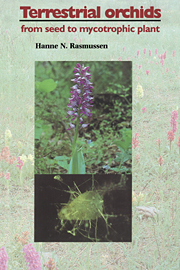Book contents
- Frontmatter
- Contents
- Acknowledgements
- Introduction
- 1 Properties of ‘dust’ seeds
- 2 Seed development
- 3 Seed survival
- 4 Requirements for germination
- 5 Fungi
- 6 Germination processes
- 7 Underground organs
- 8 Orchid mycorrhiza
- 9 Abiotic factors in growth and development
- 10 Life history and phenology
- 11 Propagation
- 12 Effects of orchid mycorrhiza
- 13 Descriptions of genera
- Appendix A Nutrient substrates mentioned in the text
- Appendix B Names and synonyms
- References
- Index
9 - Abiotic factors in growth and development
Published online by Cambridge University Press: 13 October 2009
- Frontmatter
- Contents
- Acknowledgements
- Introduction
- 1 Properties of ‘dust’ seeds
- 2 Seed development
- 3 Seed survival
- 4 Requirements for germination
- 5 Fungi
- 6 Germination processes
- 7 Underground organs
- 8 Orchid mycorrhiza
- 9 Abiotic factors in growth and development
- 10 Life history and phenology
- 11 Propagation
- 12 Effects of orchid mycorrhiza
- 13 Descriptions of genera
- Appendix A Nutrient substrates mentioned in the text
- Appendix B Names and synonyms
- References
- Index
Summary
There is a considerable body of observations on the development of orchid seedlings in vitro in relation to various physical and chemical factors. Provided that conditions in vitro support reasonably healthy growth, such observations can give us a fairly accurate idea as to how development is regulated in nature, in various soil types and during the different seasons. However, little has yet been done to supplement the laboratory evidence by setting up explantation experiments in the field.
As regards physical factors, their effect can be studied by subjecting cultures to varying regimes of temperature, light and atmosphere. In vitro cultures are not suitable for observation of the effects of moisture conditions since humidity in vitro is consistently high. The effects of chemical factors have been studied in numerous in vitro experiments with substrates of varying composition, but these observation may or may not be applicable to natural conditions. Some of the requirements of asymbiotic seedlings reflect the absence of both mycotrophy and fully functional photosynthesis, all nourishment being obtained by direct absorption from the substrate. The external requirements of symbiotic seedlings may yield some information on the needs of the orchid/fungus association in a natural substrate.
Seedlings grown in vitro pass through some developmental stages that appear to be critical. The first occurs immediately after germination when many seedlings die before a shoot tip has differentiated (Stoutamire, 1974; Van Waes, 1984).
- Type
- Chapter
- Information
- Terrestrial OrchidsFrom Seed to Mycotrophic Plant, pp. 174 - 196Publisher: Cambridge University PressPrint publication year: 1995



